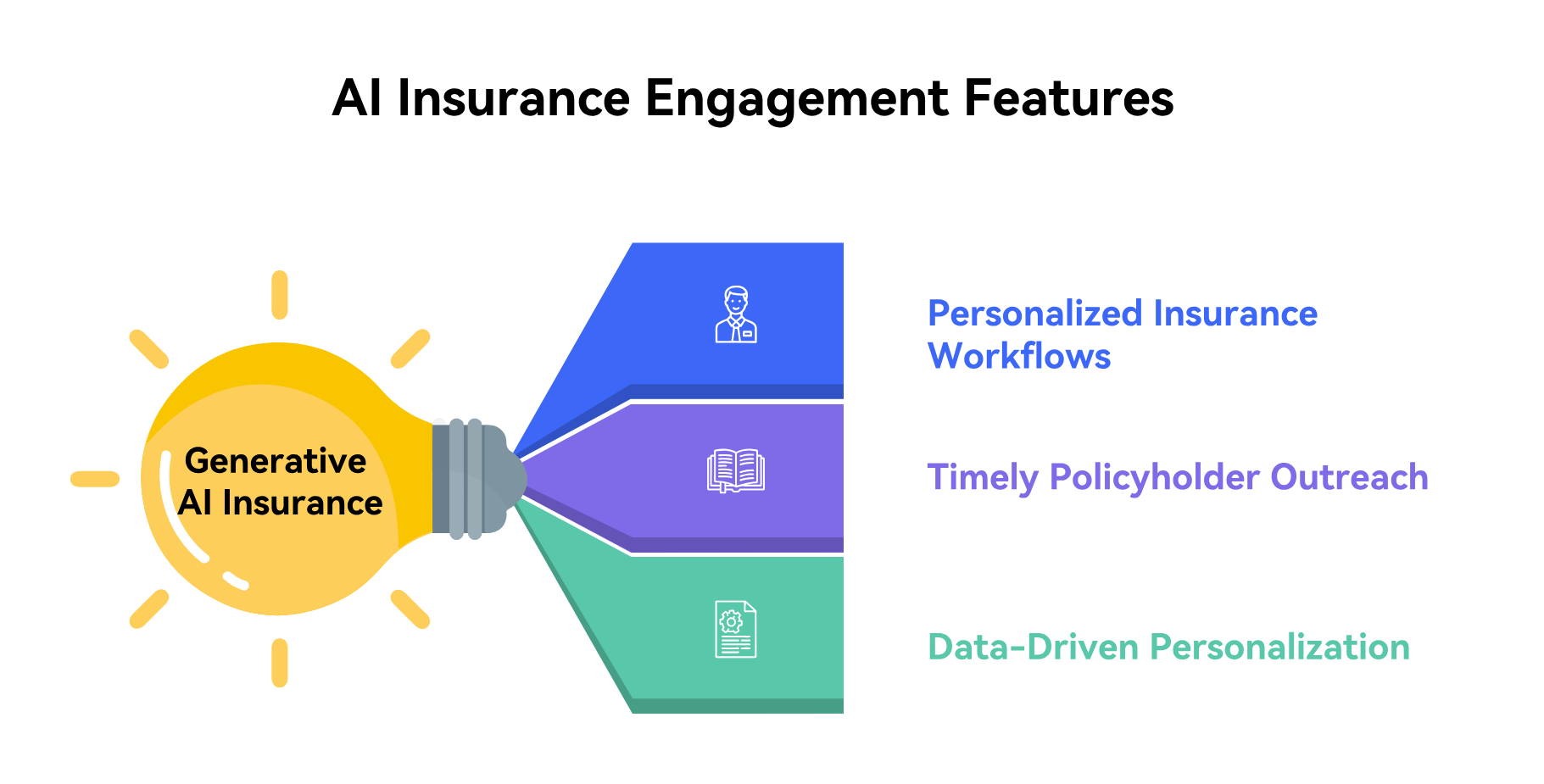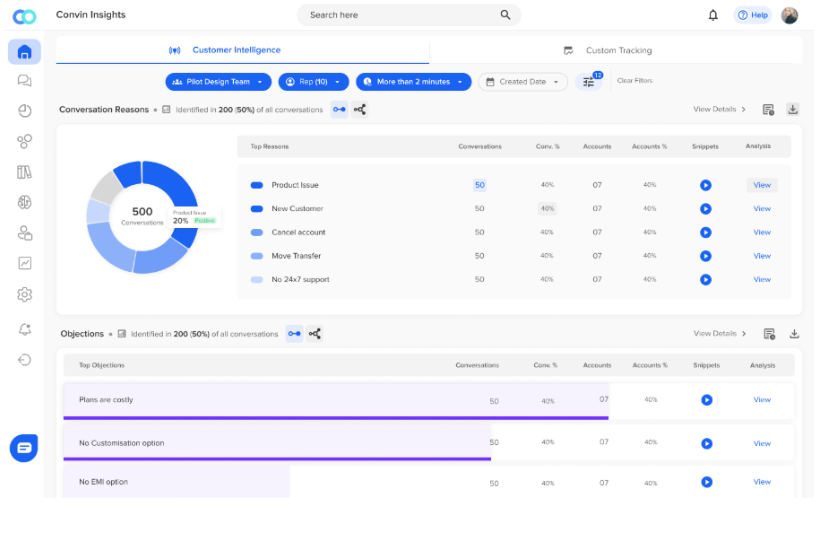In today’s insurance landscape, policyholders no longer tolerate one‑off interactions. They expect meaningful communication at every turn, from renewal nudges to fraud alerts and beyond. In fact, a recent study found that frequent digital engagement significantly increases a new policyholder’s likelihood to renew.
By leveraging generative AI in insurance, you can move from episodic contacts to continuous, proactive relationships, making every touchpoint count.
In this blog, you’ll discover how generative AI in insurance is redefining policyholder engagement, and why top insurers are treating personalised interaction as a strategic advantage. You’ll get an inside view of:
- How AI‑driven models deliver personalised messaging across renewals, reminders, and claims;
- How “always‑on” voice bots powered by generative AI in insurance are transforming support into a business driver, and
- How the tech stack from Convin, from real‑time agent assist to conversation intelligence and voice‑of‑customer tools, is already unlocking measurable results.
If you’re a VP, line‑of‑business head, or executive looking to stay ahead of the curve, this blog shows you not just why generative AI in insurance matters, but how to apply it across key touchpoints to deepen engagement and boost retention.
Engage policyholders using personalized data and AI

How Generative AI in Insurance Is Improving CX
In an industry where policyholders often interact only at purchase or claim time, generative AI in insurance changes the game.
Today’s insurers must meet policyholders at every critical moment, renewals, reminders, fraud alerts, and generative AI in insurance empowers this shift with real‑time insights and automated touchpoints.
According to one industry study, nearly one‐third of customers have abandoned a provider after just one bad experience. Personalisation and timeliness matter.
With generative AI in insurance, insurers don’t just respond, they anticipate. They deliver relevant communication to the right person at the right moment, and this transforms policyholder engagement from transactional to relational.
1. Why AI for Insurance Is Driving New Engagement Models
AI for insurance has evolved from simple automation to intelligence-driven engagement.
Generative AI in insurance enables proactive touchpoints, renewals, reminders, and fraud alerts, based on predicted behaviour. Instead of waiting for policyholders to reach out, AI initiates engagement when it senses a need. McKinsey estimates that up to 50% of service interactions can be automated, improving NPS by 20%.
This shift transforms engagement from reactive to proactive, positioning insurers as responsive and relevant.
2. How Artificial Intelligence in Insurance Meets Modern CX Demands
Customer experience (CX) in insurance hinges on timeliness and personalisation, and AI meets both demands.
Artificial intelligence in insurance supports real-time responsiveness and multi-channel engagement. With 71% of customers expecting digital self-service and tailored communications, generative models help insurers meet these expectations consistently.
AI-powered CX ensures that policyholder interactions are fast, frictionless, and personalised.
3. What Makes Generative Models Different in Insurance?
Generative AI in insurance moves beyond rigid scripts; it creates adaptive, real-time responses tailored to each policyholder’s context. It doesn’t just retrieve data; it composes relevant, human-like messages on the fly.
Whether it’s a renewal nudge, a fraud alert, or an upsell suggestion, the system adjusts language and timing based on behavioural cues. That’s where it stands apart from rule-based bots that repeat static responses regardless of customer intent.
Accenture reports that 60% of insurers are experimenting with generative AI tools to personalise interactions and improve engagement.
In essence, generative AI in insurance turns every policyholder touchpoint into a dynamic, situational conversation, driving clarity, relevance, and trust.
From delivering basic communications to triggering proactive, meaningful interactions, generative AI in insurance elevates engagement. The next section shows how personalised engagement becomes reality across every major policyholder touchpoint.
Leverage Convin AI to deepen policyholder trust
How Does AI Personalize Insurance Engagement?
In a world where policyholders expect relevance, using generative AI in insurance means engagement that feels tailored at every touchpoint. Whether it’s time for renewal, a reminder of premium due, or a fraud alert, AI for insurance enables the right message via the right channel.
1. Personalized Insurance Engagement Across Renewals, Claims & Alerts
Personalised engagement with AI allows insurers to tailor outreach based on lifecycle stage and behaviour.
If a policyholder shows reduced app activity near renewal time, the system sends an early, friendly nudge. If claim activity spikes in an unusual pattern, it flags fraud risk instantly and escalates the case. These aren't hard-coded rules; they’re real-time decisions made by generative AI in insurance, based on live inputs. A report on AI in the insurance sector states that AI‑powered personalisation is becoming essential.
With generative AI in insurance, these personalised, context‑aware workflows become operational at scale.
2. AI for Insurance: Reaching the Right Policyholder at the Right Moment
Timing is everything in insurance communication, and AI makes timing intelligent.
AI for insurance scans policyholder history, preferences, and engagement signals to determine not just what to say, but when and through which channel. If a customer prefers mobile alerts, AI delivers a reminder there. If they’ve skipped a payment or missed login activity, it adjusts the message accordingly.
A 2025 Insurity report shows policyholders value self-service, instant access to documents, and simplified billing above all else.
Generative AI in insurance enables insurers to meet these expectations proactively, before the policyholder even asks.
3. Dynamic, Data‑Backed Personalization at Every Touchpoint
Generic messaging is no longer enough; today’s policyholders expect precision.
Artificial intelligence in insurance enables insurers to react to real-life context. A policyholder relocates? AI recalculates premiums and sends a tailored coverage update. A fraud pattern surfaces? It triggers real-time alerts with minimal customer effort. Each interaction adapts to live data, not static logic. Industry commentary affirms that AI enables “stronger fraud detection and prevention” and more tailored offerings.
With generative AI in insurance, every message is timely, situational, and built for conversion.
Personalised touchpoints are just half the story. Equally important: the support layer that is always available, adaptive, and conversational. Enter the world of AI‑powered customer service and voice bots.
Personalize renewals with real-time Convin AI insights
This blog is just the start.
Unlock the power of Convin’s AI with a live demo.

Can Generative AI Automate Policyholder Support?
Support that works only during office hours or relies on scripted responses doesn’t cut it anymore. Generative AI in insurance transforms support workflows, making them proactive, conversational, and always‑on.
1. AI‑Powered Customer Service Insurance Teams Rely On
Customer expectations are rising; support must be fast, accurate, and human-like.
AI-powered customer service insurance solutions use generative AI in insurance to assist agents in real time. The system listens for tone, urgency, and context, surfacing smart prompts or escalation cues when needed. If sentiment drops, it nudges the agent with tailored responses. If the issue is repetitive, it automates resolution instantly.
With AI in the loop, support shifts from reactive to intelligent, delivering policyholder satisfaction at scale.
2. Insurance Policyholders Prefer Conversational AI Over Long Wait Times
Long hold times frustrate policyholders, and in today’s digital-first world, that’s a deal-breaker.
Conversational AI insurance solutions, powered by generative AI in insurance, offer 24/7 responsiveness through chatbots and voice bots. These systems can handle thousands of inquiries simultaneously, from renewal questions to fraud alerts, without fatigue or delay. The experience feels seamless and personal, even when no human agent is involved.
Insurers adopting conversational AI improve availability, reduce operational costs, and meet policyholders where they are, whether via mobile, web, or IVR systems.
For modern policyholders, conversational AI isn’t just a nice-to-have—it’s how they expect to be heard, helped, and engaged.
3. Voice Bots As “Always Available” Support Layers for Insurers
Modern policyholders don’t wait for business hours; they expect instant service. That’s where Convin’s AI voice bots step in.
Convin’s generative AI in insurance enables insurers to automate high-volume, routine touchpoints like renewals, reminders, and fraud alerts with 24/7 voicebot support. These bots aren’t static; they’re trained to respond contextually, using policyholder data and real-time behaviour cues to keep conversations personal and accurate.
Convin’s platform delivers:
- 24/7 availability for policy inquiries, renewals, and alerts
- Intelligent, speech-enabled interactions using NLP and conversation intelligence
- Seamless integration with internal systems for data-backed responses
- Up to 60% reduction in call center costs and 27% increase in CSAT, based on actual deployments
For insurance leaders, this means transforming support from a cost centre to a competitive differentiator, powered entirely by Convin.
With personalisation and automation in place, how does the technology stack behind all this look? Let’s dive into how Convin powers generative AI in insurance for modern insurers.
Start a generative AI pilot with Convin’s AI stack
How Convin Powers Generative AI in Insurance
When you evaluate generative AI in insurance, the solutions matter. Convin offers a focused stack designed for insurers wanting to elevate policyholder engagement across renewals, fraud alerts, support, and ongoing communication.
1. Real‑Time Agent Assist: Speed and Accuracy in Complex Calls
In high-stakes calls, renewals, fraud alerts, or escalations, agents need more than scripts. They need intelligence, at the moment.
Convin’s Real-Time Agent Assist delivers just that. It listens to ongoing conversations, surfaces the most relevant responses, flags compliance issues, and recommends contextual next steps. This support allows agents to make faster decisions and adjust on the fly, whether it’s verifying a suspicious claim or recommending an upgrade at renewal.
What makes it work? Live prompts based on speech recognition, integrated knowledge base support, and AI-driven suggestions trained on real insurance conversations. Convin reports a 27% lift in CSAT and a 21% increase in conversions for teams using Real-Time Assist.
For insurers, this tool turns every call into a performance opportunity, without sacrificing accuracy or compliance.

2. Conversation Intelligence: Analyse, Optimise, Repeat
Every insurance call holds hidden insights if you know where to look.
Convin’s Conversation Intelligence uses generative AI in insurance to capture and analyse 100% of voice and chat interactions. It doesn’t stop at transcription; it identifies sentiment trends, uncovers compliance risks, and highlights service breakdowns.
This means insurers can spot issues in renewal handling, discover friction in fraud alert workflows, or refine upsell scripts based on real customer language.
What sets Convin apart is its ability to turn unstructured conversations into structured data, fast. These insights are fed directly into training, QA, and strategy workflows, enabling continuous improvement.
The result? A smarter, more responsive insurance operation driven by what policyholders actually say and feel.
3. Voice of Customer Software Driving Data‑Backed Engagement
To improve engagement, insurers need more than feedback forms; they need intelligence.
Convin’s Voice of Customer software applies generative AI in insurance to monitor and interpret policyholder sentiment across key touchpoints like renewals, reminders, and fraud alerts. It captures verbal cues, tone shifts, and friction points, then combines them with agent behavior data to spotlight what’s working and what isn’t.
Whether it’s identifying drop-off points in renewal conversations or flagging dissatisfaction in fraud alert calls, Convin transforms voice data into real-time strategic insights. These findings help leadership adjust scripts, timing, and even product offerings with confidence.
The outcome? Smarter engagement decisions that drive satisfaction, loyalty, and long-term value.
We’ve seen the how and the who. Now let’s look ahead: what does the future hold for generative AI in insurance when it comes to policyholder experience and business value?
Train your team using conversation intelligence with Convin
What’s Next for Generative AI in Insurance Engagement
Generative AI in insurance is no longer theoretical; it’s a real-world force reshaping how insurers engage, support, and retain policyholders. From personalising renewal prompts to delivering fraud alerts in real time, AI now enables insurers to anticipate needs, automate responses, and turn every touchpoint into a trust-building opportunity.
The difference lies in execution. Insurers who succeed with generative AI in insurance aren’t just automating workflows; they’re integrating AI into every customer interaction, across every channel.
This shift calls for smart systems that deliver context-aware conversations, real-time insights, and measurable improvements in satisfaction and efficiency.
That’s where Convin comes in, an end-to-end solution built to power engagement at scale. If you’re serious about elevating policyholder experience, it’s time to see how generative AI in insurance can drive the next wave of impact for your business.
Book your Convin Demo today!
FAQ
- How is AI redefining the future of insurance?
AI is transforming the insurance industry by enabling real-time decision-making, personalising policyholder engagement, automating claims workflows, and enhancing fraud detection. Generative AI in insurance takes this further by delivering human-like interactions and generating context-aware responses, making customer experiences faster, more accurate, and more relevant.
- What are the 3 D’s of insurance claims?
The 3 D’s refer to the typical stages or tactics in insurance claims: Delay, Deny, and Defend. While historically seen as cost-containment strategies, modern insurers are replacing these with AI-driven processes that prioritise efficiency, accuracy, and transparency—enhancing trust and customer satisfaction.
- How do generative models contribute to AI?
Generative models contribute to AI by enabling machines to create content, predict next actions, and simulate human communication. In the context of generative AI in insurance, these models generate personalised policy messages, real-time support scripts, and adaptive fraud responses, making engagement more dynamic and context-driven.
- How can generative AI help insurance in detecting anomalies?
Generative AI in insurance identifies anomalies by analysing behavioural patterns, historical data, and real-time interactions to detect deviations indicative of fraud or risk. Tools like Convin use these capabilities to surface unusual claims activity, trigger alerts, and assist agents with fast, data-backed resolution.










.avif)